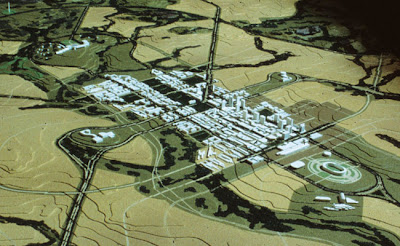Abuja
Abuja is a city that was conceived with lofty ambitions. Following Nigeria's independence from the United Kingdom in 1960, the young nation experienced a vast increase in wealth resulting from its oil reserves. Its capital at the time, Lagos, was considered overly congested and difficult to manage, as well as contentious given its coastal location far from the interior of the country. In an effort to choose a location that would be deemed neutral to the many ethnic and religious groups comprising Nigeria, a site in the centre of the nation was made into the new federal territory in 1976. A design competition for the city's master plan was held, and was won by a planning/architecture consortium from the United States.
The plan they published in 1979 has many familiar themes. There is an orientation toward landscape, with the central spine of the city pointed toward Aso Rock. There are Baroque diagonals; in this case converging upon a public square and not an institution of government power. As Lawrence J. Vale of the Massachusetts Institute of Technology argues, "Capital city urban design is the last refuge of grand axial planning..." (Gordon). Additionally, with precedents like Brasilia, Abuja also inherited some more Modernist principles such as emphasis on unimpeded traffic through elaborate roadway design and green spaces that result in wide breaks in the cityscape.
However, the plan has not had an opportunity to be fully realized. Certain government functions were moved to Abuja much too quickly, before enough infrastructure and plans for housing had been completed. This set into motion a housing crisis that continues to this day in the fast growing city. Ostensibly a democratic nation, Nigeria faced inconsistent governance for decades as succession after succession of military overthrows occurred. In 1991, Abuja was officially proclaimed the capital, and an election in 1999 ushered in a new era of relative stability. The damage had already been done to the symbolic heart of government, where the three arms (patterned after the United States) of governance were barricaded and otherwise cut off from the people, resulting in a difficult to access site. The grand diagonals also, to date, have not been built.
source: http://www.museumofthecity.org



No comments:
Post a Comment